Few things in nature are as awe-inspiring as the beautiful sight of a dogwood tree in full bloom.
These majestic trees, with their delicate blossoms and pretty leaves, are the harbingers of spring, painting landscapes with splashes of white, pink, and red.
However, the beauty of dogwoods extends beyond their springtime splendor.
Their year-round appeal, marked by summer berries, fall colors, and winter silhouettes, makes them a favorite among gardeners, landscapers, and nature lovers alike.
In this article, we explore 20 of the best dogwood tree varieties, each with its unique charm and characteristics.
Want to get your tree off to a great start? I cover all the fundamentals and provide key insights needed for success in my detailed Dogwood Tree Guide.
1. White Flowering Dogwood (Cornus Florida)
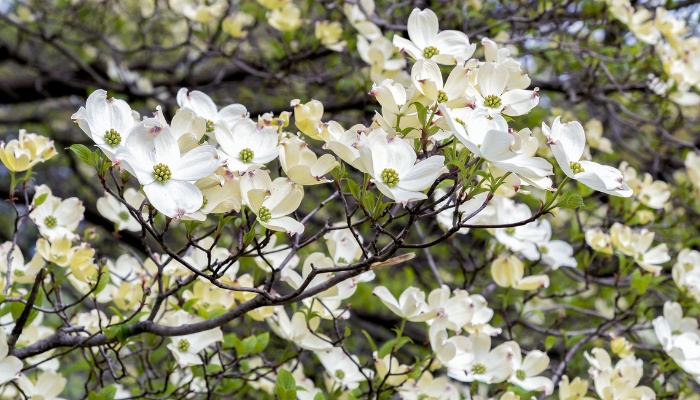
The White Flowering dogwood is a North American native that blooms in spring, its branches laden with pure-white blossoms.
These flowers, though lacking in fragrance, make a striking contrast against the tree’s dark green foliage. The tree grows to a height of 15-30 feet, forming a rounded crown.
In autumn, its leaves turn vibrant shades of red and purple, and bright-red berries adorn its branches.
Hardy and adaptable, the White Flowering dogwood thrives in a range of soil conditions, but it prefers well-drained, acidic soil.
2. Pink Flowering Dogwood (Cornus florida ‘Rubra’)

The Pink Flowering dogwood, a variant of Cornus florida, is renowned for its stunning pink blossoms that bloom in spring.
The flowers, though not fragrant, add a splash of color to any landscape. This tree grows to a height of 15-30 feet and forms a rounded canopy.
In the fall, its leaves turn brilliant red, and it produces red berries. It’s a hardy tree that prefers well-drained, acidic soil.
3. Kousa Dogwood (Cornus kousa)
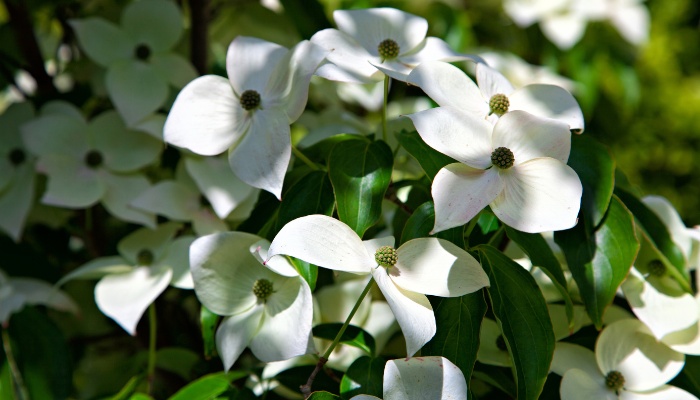
The Kousa dogwood, native to East Asia, is known for its late spring or early summer bloom of star-like white flowers. The tree grows to a height of 15-30 feet with a vase-like shape that rounds with age.
It produces pinkish-red to red berries in late summer, and its leaves turn a stunning reddish-purple in fall.
The Kousa dogwood is more resistant to diseases than some other dogwood varieties and thrives in well-drained, acidic soil.
4. Pacific Dogwood (Cornus nuttallii)
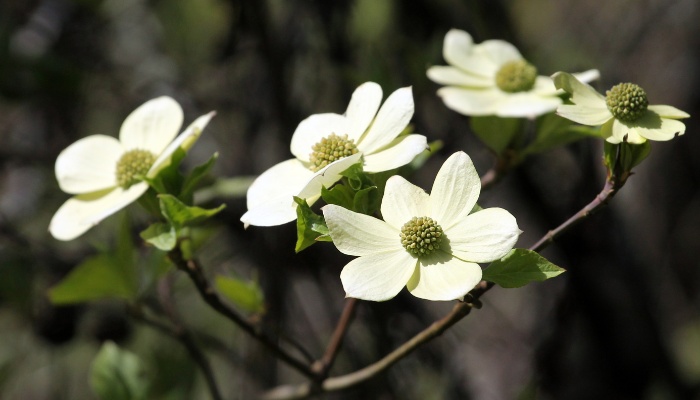
Native to western North America, the Pacific dogwood is known for its large white blossoms that appear in both spring and fall. This tree can reach up to 40 feet in height and has a layered branching structure.
It produces bright-red berries in the summer, and its leaves turn a bright red in the fall. The Pacific dogwood prefers well-drained soil and is moderately resistant to diseases.
5. Cherokee Brave Dogwood (Cornus florida ‘Comco No.1’)
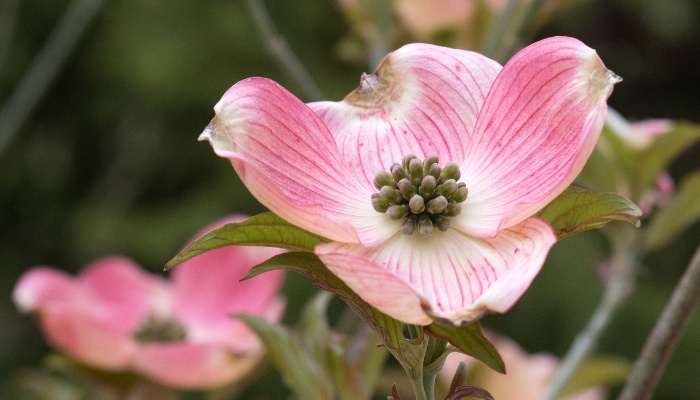
The Cherokee Brave dogwood stands out with its deep pink to reddish flowers that bloom in spring. This variety grows up to 20 feet tall and has a rounded shape.
It produces red berries in the fall, and its leaves turn a stunning purplish-red. The Cherokee Brave dogwood is known for its disease resistance and prefers well-drained, acidic soil.
6. Pagoda Dogwood (Cornus alternifolia)
The Pagoda dogwood, named for its tiered horizontal branches, blooms with clusters of white flowers in late spring.
It produces bluish-black berries in the summer, and its leaves turn reddish-purple in the fall.
The Pagoda dogwood is hardy and adaptable, thriving in a range of soil conditions. This tree can grow up to 25 feet tall.
7. Cornelian Cherry Dogwood (Cornus mas)

The Cornelian Cherry dogwood, native to Europe and Asia, is known for its small yellow flowers that bloom in early spring before the leaves appear.
This tree can reach up to 25 feet in height and has a rounded shape. It produces bright-red, cherry-like fruits in the summer, and its leaves turn a vibrant red in the fall.
The Cornelian Cherry dogwood is a hardy tree that can tolerate a range of soil conditions.
8. Stellar Pink Dogwood (Cornus x ‘Rutgan’)
The Stellar Pink dogwood, a hybrid variety, is admired for its soft pink flowers that bloom in late spring. This tree grows up to 20 feet tall and has a rounded form.
It produces small, bird-attracting berries in the summer, and its leaves turn a bold red in the fall.
Stellar Pink dogwood is known for its resilience in colder climates and its ability to thrive in a variety of soil types.
9. Constellation Dogwood (Cornus x ‘Rutcan’)

The Constellation dogwood, another hybrid variety, is known for its profuse white flowers that bloom in late spring. This tree can reach up to 30 feet in height and has a pyramidal shape.
It produces red berries in the fall, and its leaves turn a stunning purplish-red.
The Constellation dogwood is notable for its resistance to dogwood anthracnose, a common disease among dogwoods, and it prefers well-drained, acidic soil.
10. Venus Dogwood (Cornus x ‘KN30-8’)

The Venus dogwood, a hybrid variety, boasts large white flowers that bloom in late spring. This tree grows up to 20 feet tall and has a rounded form.
It produces orange-red berries in the fall, and its leaves turn a bright red. The Venus dogwood is known for its adaptability to both heat and cold, and it thrives in a variety of soil conditions.
11. Stardust Dogwood (Cornus x ‘KN4-43’)

The Stardust dogwood, a hybrid variety, is known for its abundant white flowers that bloom in late spring. This tree can reach up to 25 feet in height and has a rounded form.
It produces red berries in the fall, and its leaves turn a stunning purplish-red. The Stardust dogwood is notable for its resistance to powdery mildew, a common fungal disease, and it prefers well-drained, acidic soil.
12. Milky Way Dogwood (Cornus kousa ‘Milky Way’)

The Milky Way dogwood, a variant of Cornus kousa, boasts large white flowers that bloom in early summer. This tree grows up to 20 feet tall and has a vase-like shape.
It produces pinkish-red berries in late summer, and its leaves turn a vibrant red in the fall.
The Milky Way dogwood is known for its tolerance to a variety of soil conditions and its resistance to common dogwood diseases.
13. Aurora Dogwood (Cornus x ‘Rutban’)
The Aurora dogwood, a hybrid variety, is admired for its profuse white flowers that bloom in late spring. This tree can reach up to 20 feet in height and has a rounded form.
It produces red berries in the fall, and its leaves turn a stunning purplish-red. The Aurora dogwood is notable for its resistance to dogwood borer, a common pest of dogwood trees.
14. Giant Dogwood (Cornus controversy)

The Giant dogwood, native to East Asia, is known for its clusters of small, fragrant, white flowers that bloom in late spring.
This tree can reach up to 50 feet in height and has a tiered horizontal branching structure. It produces black berries in the fall, and its leaves turn a stunning red.
The Giant dogwood is notable for its tolerance to a variety of soil conditions and its resistance to common dogwood diseases.
15. Himalayan Dogwood (Cornus capitata)

The Himalayan dogwood, native to the Himalayas, boasts large, fragrant yellowish-white flowers that bloom in early summer. This tree grows up to 20 feet tall and has a rounded form.
It produces strawberry-like fruits in the fall, and its leaves turn a vibrant red. The Himalayan dogwood is known for its adaptability to both heat and cold, and it thrives in a variety of soil conditions.
16. Ragin Red Dogwood (Cornus florida ‘Ragin Red’)
The Ragin Red dogwood stands out with its deep-red flowers that bloom in spring. This variety grows up to 20 feet tall and has a rounded shape.
It produces red berries in the fall, and its leaves turn a stunning purplish-red. The Ragin Red dogwood is fairly disease resistant and prefers well-drained, acidic soil.
17. Cherokee Princess Dogwood (Cornus florida ‘Cherokee Princess’)
The Cherokee Princess dogwood is renowned for its large, fragrant white blossoms that bloom in early spring. This tree grows up to 25 feet tall and has a rounded form.
It produces red berries in the fall, and its leaves turn a vibrant red. The Cherokee Princess dogwood is known for its cold hardiness and prefers well-drained, acidic soil.
18. Satomi Dogwood (Cornus kousa ‘Satomi’)

The Satomi dogwood, a variant of Cornus kousa, is known for its pink flowers that bloom in late spring. This tree can reach up to 25 feet in height and has a rounded shape.
It produces pinkish-red berries in late summer, and its leaves turn a stunning reddish-purple in the fall.
The Satomi dogwood is notable for its resistance to dogwood anthracnose and prefers well-drained, acidic soil.
19. Wolf Eyes Dogwood (Cornus kousa ‘Wolf Eyes’)
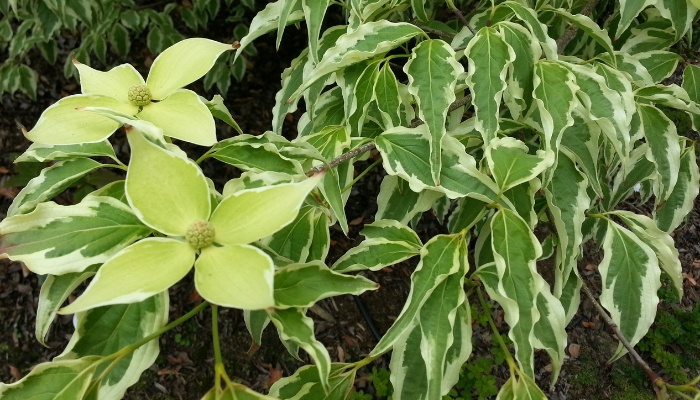
The Wolf Eyes dogwood stands out with its variegated leaves and small, star-like white flowers that bloom in late spring. This tree grows up to 10 feet tall and has a rounded form.
It produces pinkish-red berries in late summer, and its leaves turn a vibrant red in the fall. The Wolf Eyes dogwood is known for its heat tolerance and prefers well-drained, acidic soil.
20. Weeping Dogwood (Cornus florida ‘Pendula’)
The Weeping dogwood, a variant of Cornus florida, is admired for its weeping form and white flowers that bloom in spring. This tree grows up to 15 feet tall.
It produces red berries in the fall, and its leaves turn a stunning purplish-red. The Weeping dogwood is known for its cold hardiness and prefers well-drained, acidic soil.
Conclusion
Dogwood trees, with their stunning blossoms and year-round appeal, are a testament to the beauty and diversity of nature.
With so many pretty dogwood trees available, it can be tough to decide which is best. My suggestion? Get more than one! Happy gardening!
